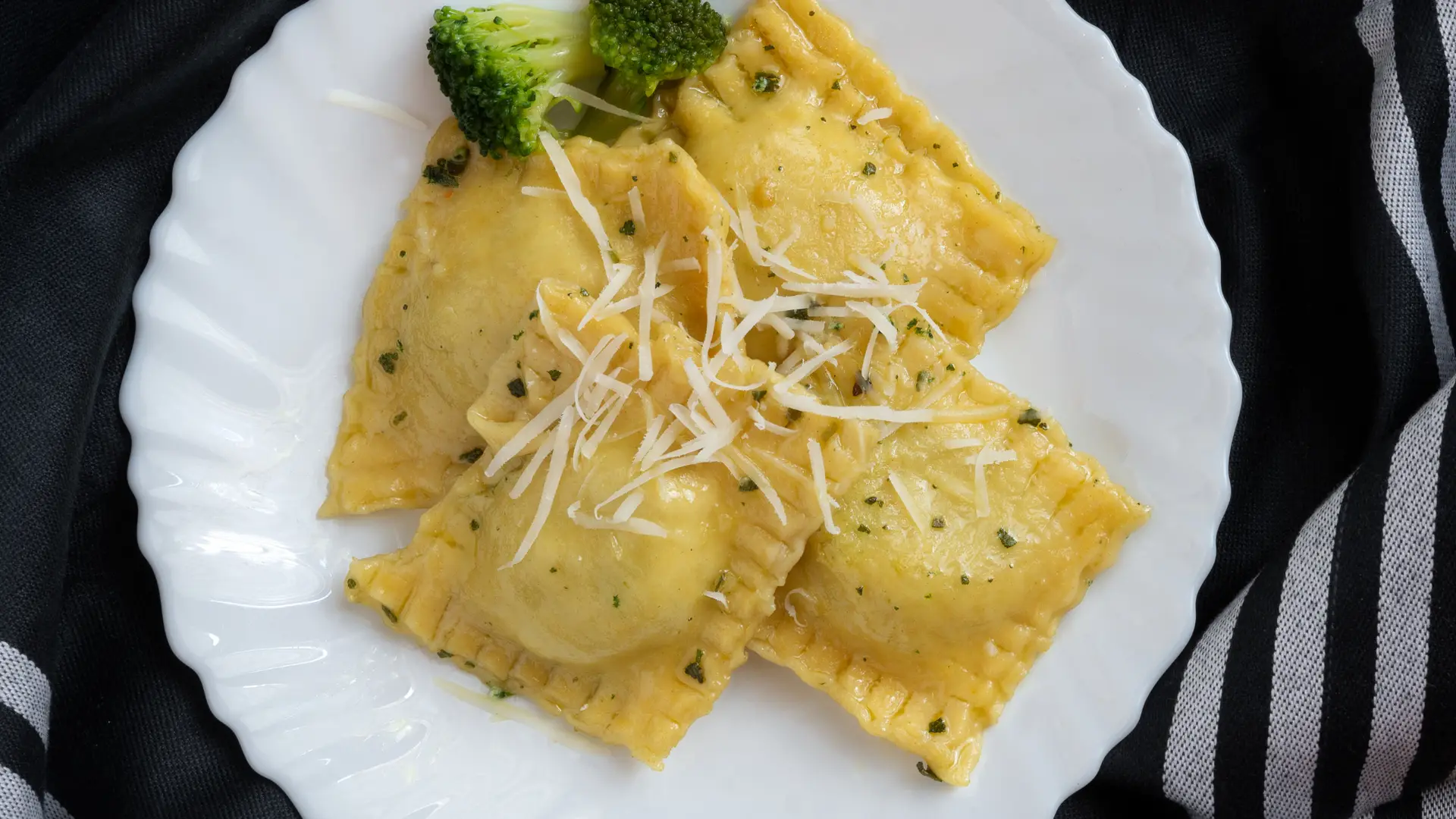Imagine biting into fresh, soft ravioli filled with real Italian flavors. Did you know we eat over 20 pounds of pasta yearly? Making homemade ravioli can take your cooking to the next level, making it as good as a restaurant’s.
Whether you love pasta or are new to cooking, this simple ravioli recipe will show you how to make these tasty Italian treats. With just a few ingredients and some practice, you can make a meal that feels like a trip to Italy.
Table of Contents
Understanding the Art of Traditional Italian Ravioli Making
The history and culture of Italian cuisine are closely tied to making handmade pasta, especially traditional ravioli. This dish has won hearts around the world. It shows Italy’s rich culinary traditions and the differences between regions.
Origins and Cultural Significance
Ravioli started in the 14th century in Italy. It was a dish for special times, like celebrations and holidays. Making these pasta pockets by hand showed the skill and hard work of Italian cooks.
Regional Variations Across Italy
- In Italy, traditional ravioli has changed, showing many fillings, shapes, and ways to make it.
- In places like Emilia-Romagna and Piedmont, ravioli is filled with cheese, meat, or veggies. It’s often served with creamy sauces.
- In the south, like Campania and Sicily, ravioli fillings are more varied. They include seafood, herbs, and local foods.
- Every Italian region has its own ravioli style. This shows the local cooking traditions and the creativity of the cooks.
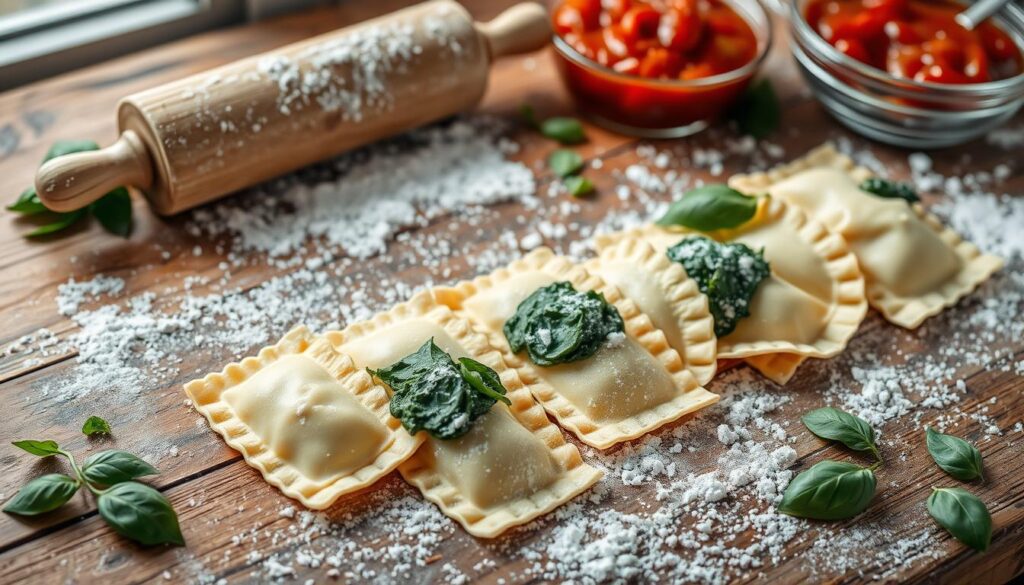
The lasting impact of traditional ravioli in Italian cuisine shows Italy’s love for handmade pasta. It celebrates the unique tastes of each region.
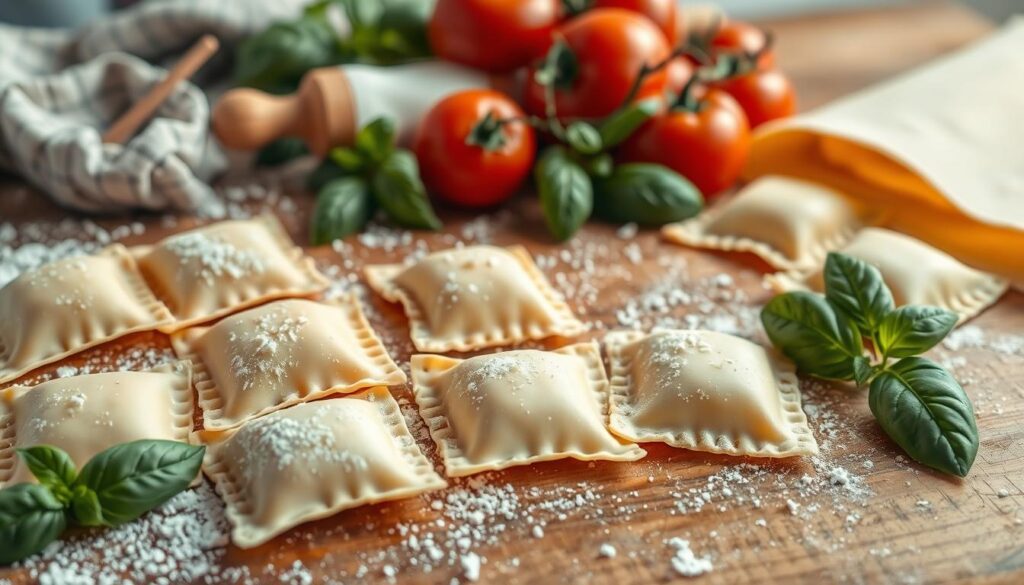
Essential Tools and Equipment for Homemade Ravioli
Want to make delicious homemade ravioli? You’ll need some key tools and equipment. From pasta making tools to the ravioli cutter, each tool is crucial. They help turn simple ingredients into tasty dishes.
The pasta machine is at the center of making ravioli. It lets you roll out dough to the right thickness. This makes your fillings’ base smooth and soft. Choose a strong, adjustable pasta machine for best results.
- A rolling pin is also essential. It helps roll out your pasta dough evenly.
- A ravioli cutter is vital for shaping and sealing your ravioli. It has crimped wheels that cut and seal the dough at once.
- A sharp knife or pizza cutter can also cut your ravioli into shapes.
Remember, a good work surface is important. Use a clean, floured countertop or table. This prevents your pasta dough from sticking.
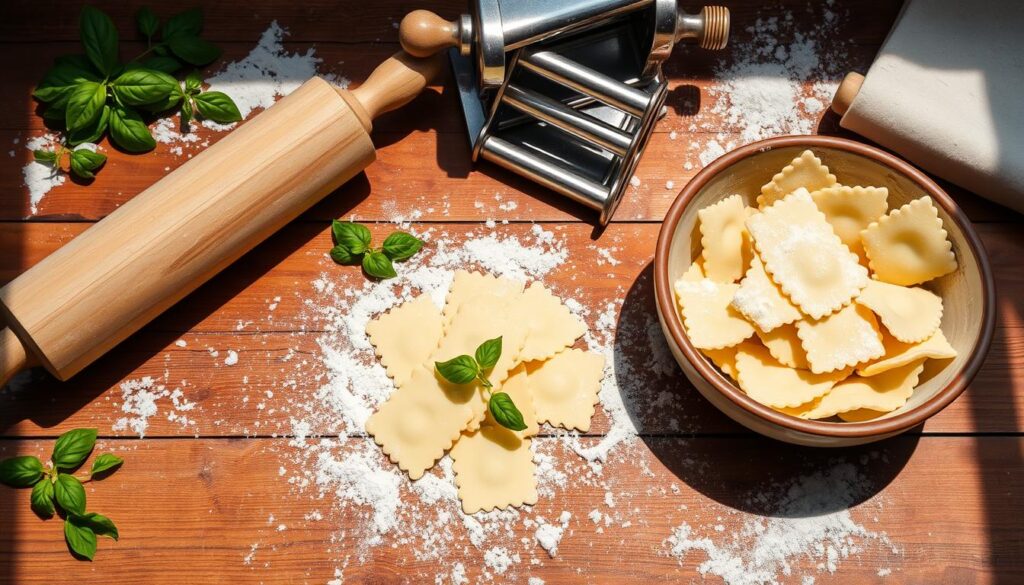
With the right tools, you’re set to make tasty homemade ravioli. It will wow your family and friends. Quality tools are key to success. So, invest in them and start your ravioli-making journey.
Perfect Pasta Dough: Ingredients and Proportions
Making the perfect pasta dough is the first step to delicious homemade ravioli. It doesn’t matter if you’re new to pasta dough or an expert in Italian cuisine. Knowing the right ingredients and their amounts is crucial for the right texture and taste.
Choosing the Right Flour
The flour you pick greatly affects your pasta dough. For traditional Italian cuisine, all-purpose flour or 00 flour (also known as doppio zero) are top choices. All-purpose flour gives a strong base, while 00 flour makes the dough silky and delicate.
The Role of Eggs in Pasta Making
Eggs are vital in pasta dough for adding richness, structure, and binding. The rule is one egg for every 100 grams of flour. But, you can tweak the egg-to-flour ratio to get the texture and moisture you want.
Adding Optional Ingredients
- Semolina flour: Adding a bit of semolina flour (about 10-20% of the total flour) gives a nice coarse texture and a nutty taste to your pasta dough.
- Olive oil: A little high-quality olive oil can make your pasta dough more pliable and shiny.
- Herbs and spices: Try adding fresh herbs or dried spices to give your homemade ravioli more depth and complexity.
The secret to perfect pasta dough is finding the right mix of ingredients. Adjust the amounts based on what you like and the dish you’re making.
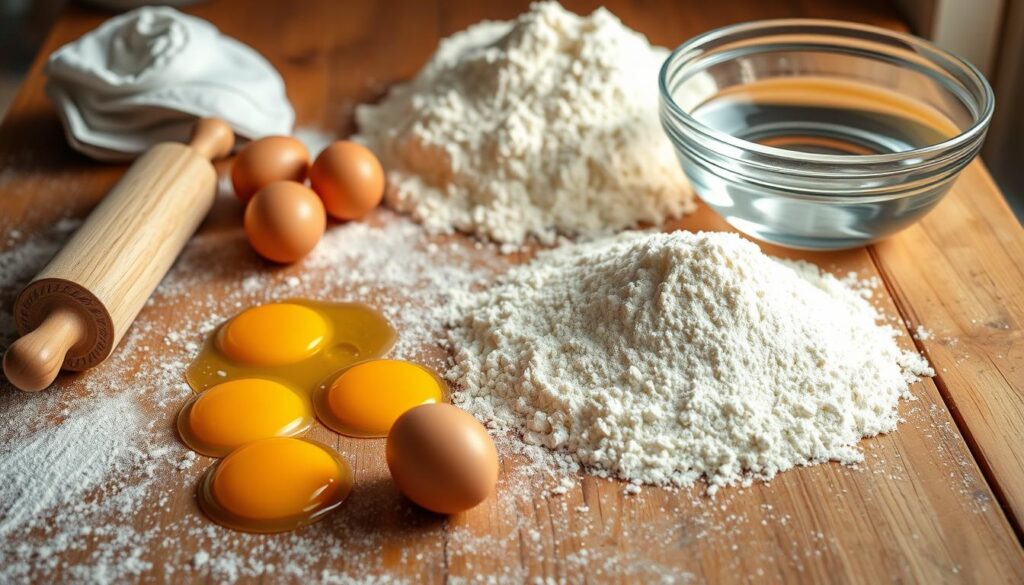
Step-by-Step Guide to Making Homemade Ravioli
Making your own ravioli is a fun and rewarding experience. It lets you create delicious, authentic Italian comfort food at home. This guide will help you make handmade pasta and fill it with tasty fillings, whether you’re new or experienced.
To start, prepare your pasta dough. Mix flour, eggs, and a bit of salt until it comes together. Knead it for a few minutes, then rest it for at least 30 minutes before rolling it out.
- Dust a clean work surface with flour and roll the dough into thin sheets, about 1/8-inch thick.
- Place tablespoon-sized portions of your preferred filling onto one sheet of pasta, leaving space between each mound.
- Brush the exposed pasta around the mounds with water, then carefully place a second sheet of pasta on top, pressing around the filling to seal the ravioli.
- Use a ravioli cutter or a sharp knife to cut the individual ravioli, ensuring that each one is properly sealed.
- Bring a large pot of salted water to a boil and gently drop the homemade ravioli into the water. Cook for 2-3 minutes, or until they float to the surface.
With these simple steps, you’ll have a delicious batch of homemade ravioli ready to enjoy. Try different fillings and shapes to make your own unique version of this classic Italian dish.
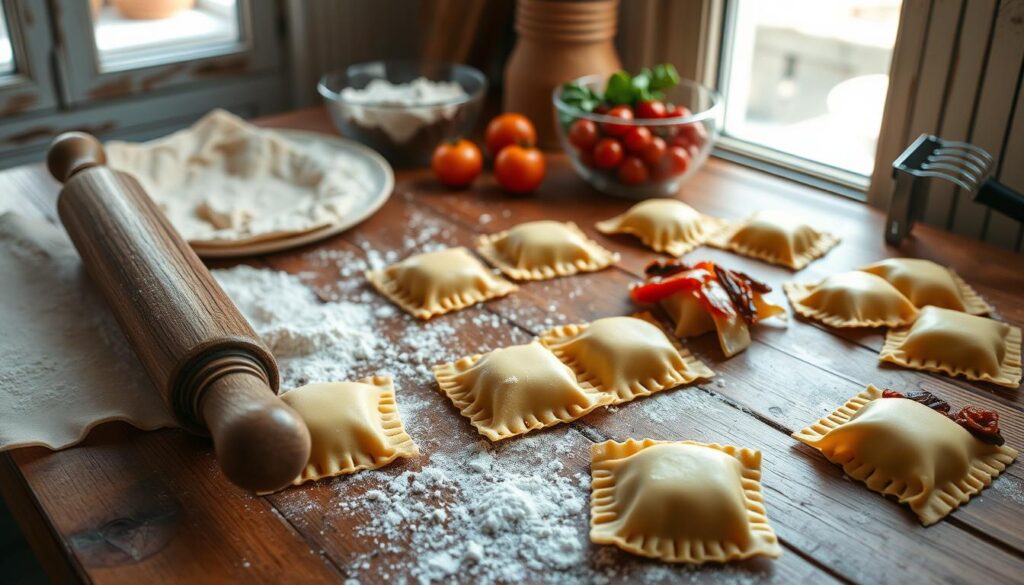
Classic Ravioli Filling Combinations
Making homemade ravioli is an art. The fillings are the heart of this Italian dish. You can choose from cheese, meat, or vegetarian options. Each choice can make your ravioli taste amazing.
Cheese-Based Fillings
Cheese fillings are a favorite in Italian cuisine. Ricotta, Parmesan, and mozzarella are often mixed together. Fresh herbs like basil or parsley add flavor.
For a creamier filling, mix ricotta with mascarpone or egg yolk.
Meat-Based Fillings
Meat fillings are great for those who want something hearty. Ground beef, pork, or a mix of both are simmered with onions, garlic, and spices. Shredded chicken or Italian sausage are also tasty choices.
Vegetarian Options
- Roasted Vegetable Medley: A colorful mix of eggplant, zucchini, bell peppers, and onions, seasoned with herbs and spices.
- Spinach and Ricotta: A classic mix of creamy ricotta and fresh, sautéed spinach.
- Mushroom Medley: A blend of sautéed mushrooms, like cremini, shiitake, and oyster, with Parmesan and herbs.
Creating great homemade ravioli is all about finding the right balance. Try different fillings and add your own twist to classic ravioli fillings.
Mastering the Art of Ravioli Shaping
Making delicious homemade ravioli is a true art. It’s all about mastering the shaping techniques to get that perfect Italian taste. Whether you’re experienced or new to handmade pasta, learning the ravioli shaping techniques can make your homemade ravioli even better.
Shaping your ravioli can change how they look and taste. We’ll cover the key techniques to help you become a pro at ravioli shaping.
- The Traditional Square Ravioli: This classic shape is a must in Italian cooking. Cut the pasta dough into squares or rectangles. Place some filling in the center and fold the dough over to seal it tightly.
- The Half-Moon Ravioli: For a more detailed design, try the half-moon shape. Roll the dough into strips, add filling, and fold it to make a half-moon. Use a tool to seal and separate the ravioli.
- The Circular Ravioli: Make your homemade ravioli look elegant by shaping them into circles. Roll the dough thin, cut out circles, and fill them with your favorite ingredients.
Choosing the right shape is important, but the key is to seal the filling well. This prevents leakage when cooking. Try different techniques to find what works best for you.
| Ravioli Shaping Technique | Description | Visual Appeal | Ease of Execution |
|---|---|---|---|
| Traditional Square Ravioli | Simple and classic shape | Straightforward and elegant | Easy for beginners |
| Half-Moon Ravioli | Slightly more intricate design | Visually appealing and refined | Moderately challenging |
| Circular Ravioli | Elegant and sophisticated shape | Beautifully presented | Requires more skill and precision |
The fun of making homemade ravioli is in the journey. Be creative, have fun, and let your skills grow as you master ravioli shaping.
Common Mistakes to Avoid When Making Ravioli
Making homemade ravioli can be a fun and rewarding task. But, it comes with its own set of challenges. Knowing the common mistakes helps you avoid them and make perfect pasta dishes.
Dough Thickness Issues
One big problem is dough that’s too thin or too thick. If it’s too thin, it tears easily and leaks. If it’s too thick, it’s dense and overpowers the filling’s taste.
To get the dough just right, follow these tips:
- Use a pasta roller or rolling pin for even thickness.
- Divide the dough into smaller parts for better control.
- Dust the work surface and dough with flour to prevent sticking.
- Try for a thickness of about 1/8 inch, adjusting as you go.
Filling and Sealing Problems
Another issue is filling and sealing the ravioli wrong. Too much filling can cause leaks, and not sealing well can spill the filling during cooking.
To fix these problems, try these tips:
- Use a spoon or piping bag for the filling, leaving space to seal.
- Moisten the dough edges with water or egg before sealing.
- Press the edges together with a fork or fingers for a tight seal.
- Trim the edges to make the ravioli look neat and clean.
By avoiding these mistakes and using these tips, you’ll make delicious and beautiful homemade ravioli.
Sauce Pairings for Your Homemade Ravioli
Improving your homemade Italian dishes is more than just the dough and fillings. The sauce you pick can make or break your dish. Try out different sauces that match the taste of your Italian cuisine and ravioli sauces.
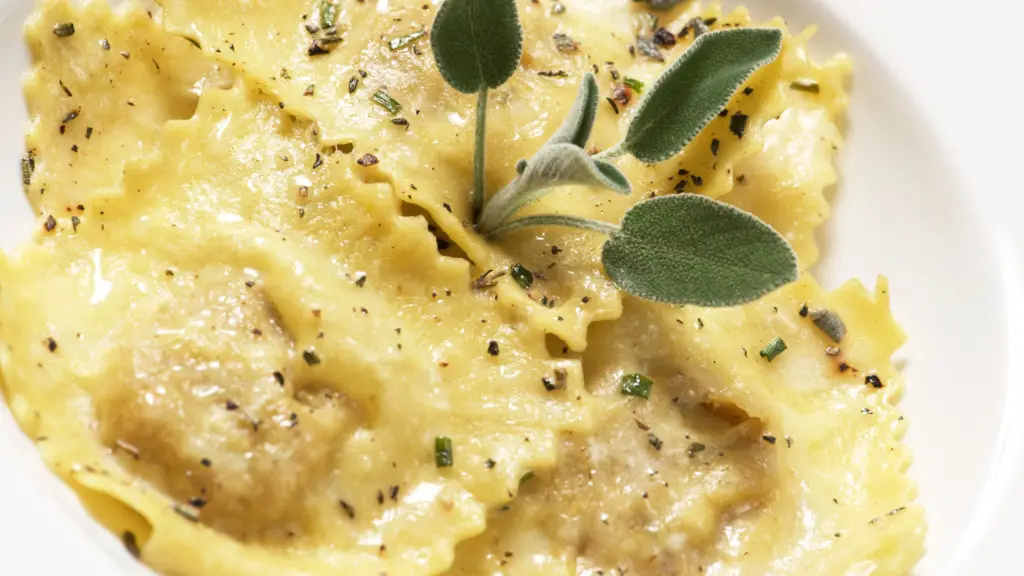
A simple tomato-based sauce is a classic choice. Its bright taste and rich tomato flavor balance the richness of your homemade ravioli. You can add herbs, garlic, and red wine to make it even better.
For a richer taste, cream-based sauces are great. A smooth béchamel or a rich Alfredo sauce can make your ravioli a cozy Italian meal. These sauces are perfect with cheese-filled ravioli, blending flavors well.
For a lighter option, try olive oil with herbs. Herbs like basil, parsley, or rosemary add a fresh taste to your ravioli. It’s a light and refreshing choice.
Remember, the goal is to let your Italian cuisine and ravioli sauces stand out. Try different sauces to find the best match for your homemade ravioli.
Storage and Freezing Tips
Storing your homemade ravioli right is key to keeping it fresh and tasty. For ravioli that’s just made, you can keep it in the fridge for up to 3 days. Just put it in an airtight container or plastic bag and keep it in the coldest fridge spot.
Fresh Storage Methods
For ravioli you’ll use soon, you can store it on a lightly floured baking sheet in the fridge. This keeps the pasta from sticking. Don’t forget to cover the sheet with plastic wrap or a damp towel to keep the ravioli moist.
Freezing Techniques
Freezing is a good choice if you want to keep your ravioli for longer. Lay the ravioli out on a parchment-lined baking sheet and freeze until they’re firm, about 2 hours. Then, put them in an airtight freezer-safe bag or container. This stops them from sticking together. When you’re ready to cook, just boil them for 2-3 minutes longer than fresh ones.
Explore our Italian collection for more timeless recipes and culinary inspiration.
FAQ
What is the difficulty level and time commitment for making homemade ravioli?
Making homemade ravioli is a rewarding experience. It takes some time and effort. The difficulty level is moderate, but with the right tools and techniques, you can make restaurant-quality pasta at home.
The process, from preparing the dough to filling and shaping the ravioli, can take 1 to 2 hours. This depends on your experience and the recipe’s complexity.
What are the essential tools and equipment needed for making homemade ravioli?
To make homemade ravioli, you need a few essential tools. You’ll need a pasta machine or rolling pin for rolling out the dough. A ravioli cutter or sharp knife is needed for cutting the dough.
You also need a clean work surface for assembly. A mixing bowl, a fork or whisk, and a saucepan for boiling the ravioli are necessary too.
What ingredients are needed to make the perfect pasta dough for ravioli?
The key ingredients for the perfect pasta dough are flour, eggs, and water. The type of flour, like all-purpose or semolina, affects the dough’s texture and flavor. Eggs bind the dough and add richness.
Water helps achieve the right consistency. You can also add olive oil or herbs to enhance the flavor of your homemade ravioli.
What are some classic ravioli filling combinations?
There are many delicious filling options for homemade ravioli. Cheese-based fillings include ricotta, parmesan, and mozzarella. Meat-based fillings often feature ground beef, pork, or a combination of the two.
Vegetarian options include spinach, mushrooms, or roasted vegetables.
How do I properly shape and seal homemade ravioli?
Shaping and sealing homemade ravioli is crucial. The traditional square shape is a good starting point. You can also try half-moon or circular shapes.
To seal the ravioli, use a small amount of filling. Press the edges firmly to create a secure seal. This prevents leakage during cooking.
What are some common mistakes to avoid when making homemade ravioli?
Common mistakes include rolling the dough too thin or too thick. Overfilling the ravioli and not sealing the edges properly are also issues.
Issues with dough thickness can lead to tearing or uneven cooking. Overfilling can cause the ravioli to burst during boiling. Make sure to seal the edges tightly to prevent leakage.
How should I store and freeze homemade ravioli?
For fresh ravioli, store them in the refrigerator for up to 3 days. Cover them with a damp towel or in an airtight container.
To freeze homemade ravioli, place them in a single layer on a baking sheet. Freeze until firm, then transfer to an airtight container or freezer bag. Frozen ravioli can be stored for up to 3 months. When ready to cook, boil the frozen ravioli directly from the freezer.

